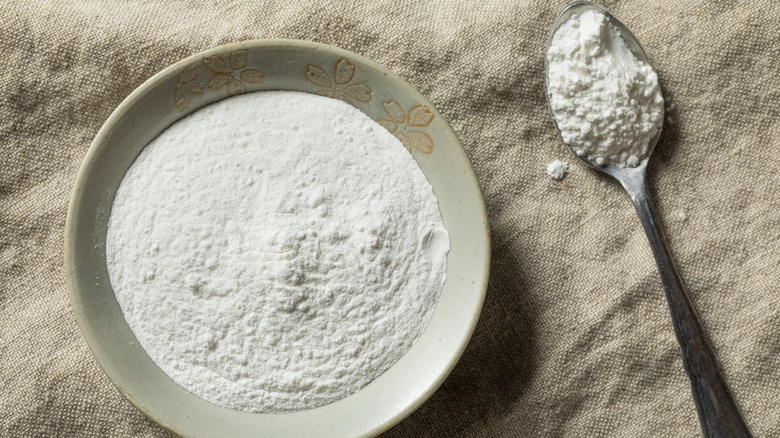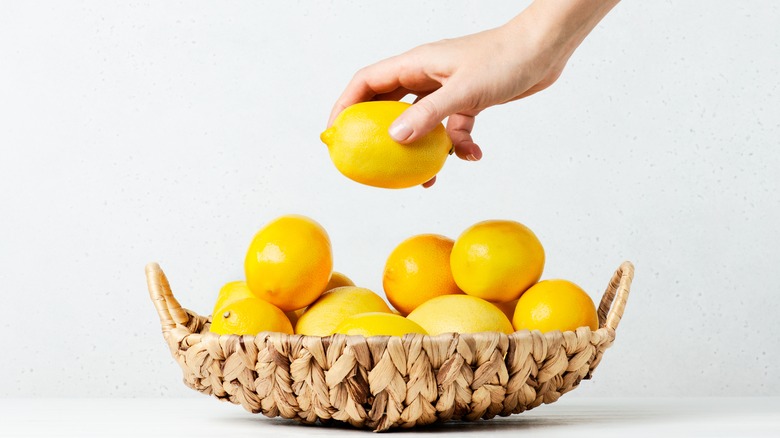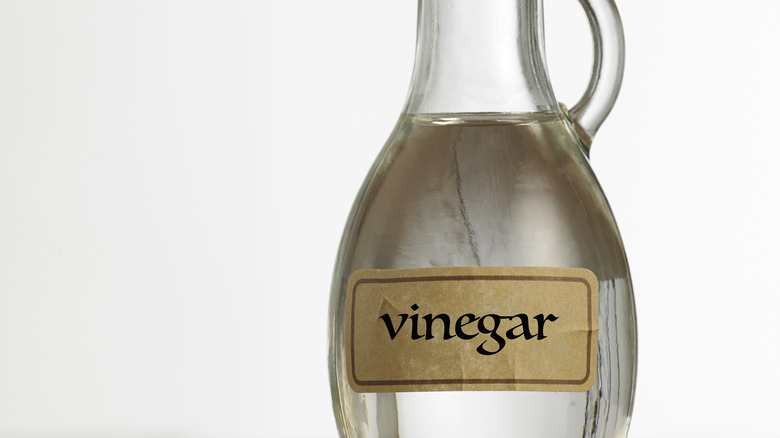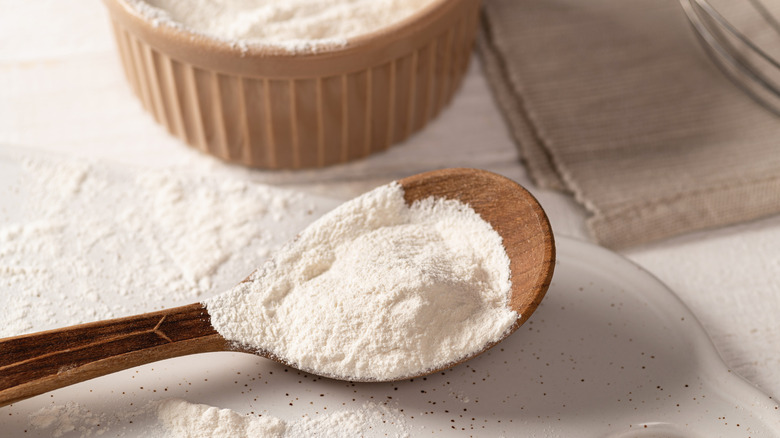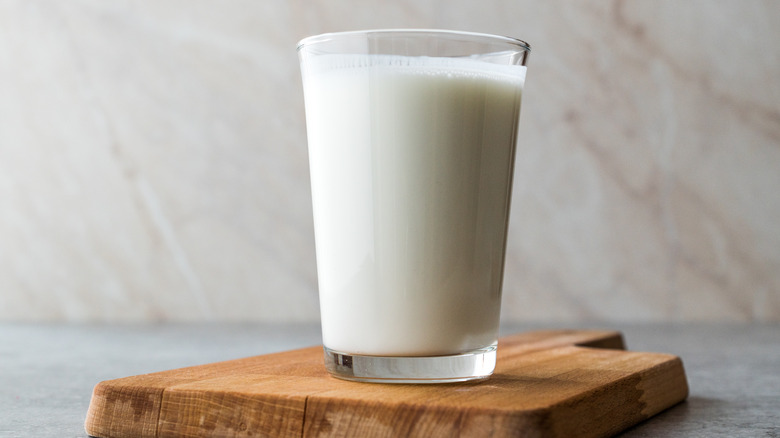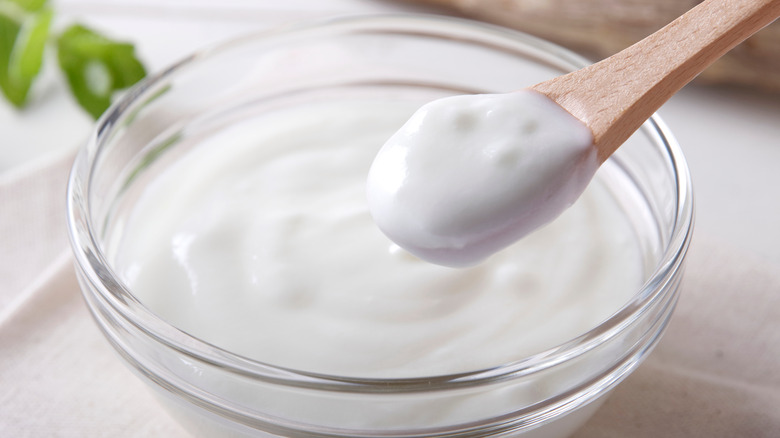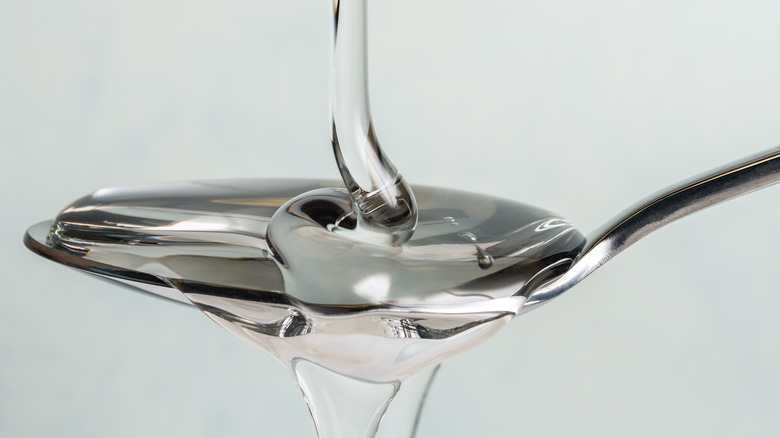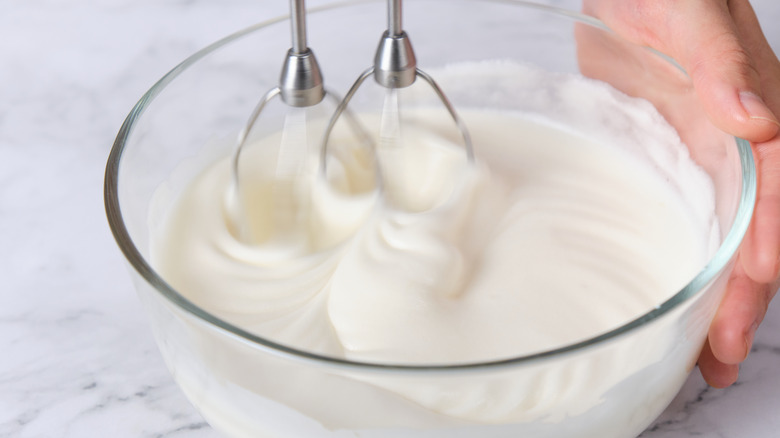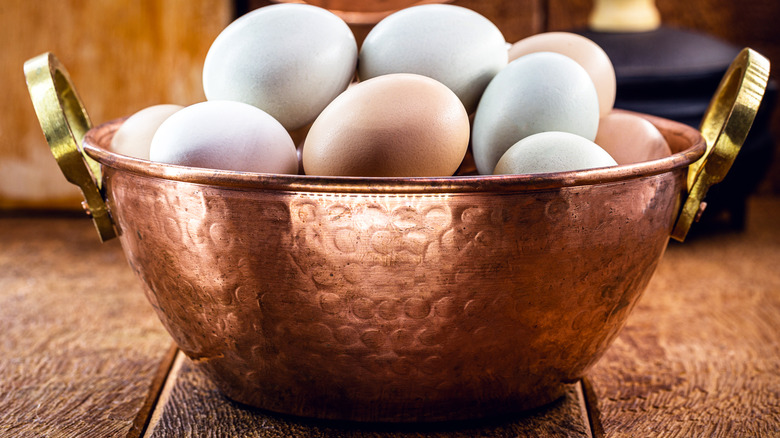The 9 Absolute Best Cream Of Tartar Substitutes
Nothing is more frustrating than starting a recipe and finding out that you're missing one of the key ingredients. Cream of tartar is an ingredient used in very specific instances and is commonly overlooked when gathering essentials. If you find yourself emptying your spice cupboard with none in sight, we've got some suitable cream of tartar substitutes you can use and still end up with a tasty and impeccable final product.
So what is cream of tartar? Known by its chemical name, potassium bitartrate, it is most often used as a stabilizer for recipes with whipped egg whites or as a leavening agent in baked goods. Potassium bitartrate is formed during the winemaking process (via ThoughtCo.). As fermentation happens, the potassium bitartrate precipitates and forms crystals inside the winemaking casks. These can be collected and processed into the cream of tartar we use in everyday recipes. This process is also why you can't make cream of tartar at home, and we have to lean on substitutions rather than homemade powder.
Potassium bitartrate has acidic properties but does not add flavor to recipes, making it an ideal ingredient for baked goods or candy. This pantry staple has a pH of 3.5 (via GC Chemicals), and this acidity is both a leavener to give volume to baked goods and a stabilizer to create stronger, stiffer whipped egg whites.
If you've thoroughly searched your spice rack and can't find this fine-powdered ingredient, there are several options you likely do have on hand that will produce similar results. These easy-to-find swaps will help save your recipe without sending you on a trip to the store.
1. Lemon juice
For nearly all recipes that call for this cream of tartar, lemon juice is a great substitute. According to Science Notes, its pH is between 2-3, making it slightly less acidic than potassium bitartrate, but still a very similar acidity.
Lemon juice is especially great in baked goods because its flavor is so mild. Cream of tartar helps make cookies chewier by preventing sugar crystalization. The crystallized sugars can create crispy, crunchy cookies. Lemon juice's properties, specifically citric acid, help to break down sucrose into the simpler glucose and fructose, which are less likely to crystalize (via Wekiva Culinary), making cookies fluffy, chewy, and absolutely delicious.
This acidic characteristic also makes lemon juice an excellent substitute for the potassium bitartrate in candy making. The citric acid helps break down sugars, like in baking, and creates non-crystalline candy (via Compound Interest), like lollipops and caramels. This means you don't have gritty bites of sugary candy and can enjoy smooth, clear, or crunchy candy as it was intended.
Lastly, lemon juice is also a great stabilizer for eggs in recipes. Per Science of Cooking, adding acid to egg whites while whipping them to stiff peaks will prevent them from deflating and collapsing. This is because adding acid helps to reduce the bonds forming between egg proteins.
We're not saying we have a favorite substitute for this powdery leavening agent, but lemon juice is pretty ideal. It adds the right amount of acidity and subtle flavor and creates perfectly puffy baked goods and smooth, shiny candy. To substitute this citrus juice for potassium bitartrate, use 1 teaspoon of lemon juice for every ½ teaspoon of cream of tartar in the recipe. Fresh lemon juice is best, but if you only have bottled, it will still work well when you use the same substitution ratio.
2. White vinegar
Another great acidic replacement is distilled white vinegar, a common acid used in cooking to stabilize eggs. It is similar to potassium bitartrate in that it has a pH of 2.5 and is acidic enough to prevent deflating in your perfectly whipped eggs.
White vinegar is ideal for making meringues and soufflés. In fact, many recipes call for it in the ingredient list. It creates a stiffer consistency by stabilizing the egg whites, much like lemon juice, as it cross-links the egg proteins and creates firmer whites (via Chemistry Views). Meringues and soufflés also often have a bold flavor like passionfruit, dark chocolate, or even savory notes, like in a fluffy cheese soufflé, that pair well with the somewhat intense flavor of vinegar.
However, white vinegar doesn't shine as brightly as a substitute in some baked sweets, and it has a very distinct and robust flavor that doesn't add a tasty quality to desserts. For sweet recipes like angel food cakes, candies, cookies, and other baked goods, lemon juice lends a more subtle flavor while still performing the same tasks as white vinegar as a substitute.
To use vinegar as a substitute for potassium bitartrate, you'll want to use about four times as much. So for every ¼ teaspoon of cream of tartar, you'll use a full teaspoon of vinegar. You may want to remove some liquid from elsewhere in the recipe to keep the consistency correct.
3. Baking powder
For baked goods, baking powder is a fine substitute because some versions, according to Chemistry Views, are actually made from a mixture of baking soda and potassium bitartrate. So if you have baking powder on hand, even if it doesn't contain potassium bitartrate, just omit any baking soda and use 1½ teaspoons of baking powder for every teaspoon of cream of tartar to get similar results.
Baking powder is used as a leavening agent in baked goods. Leavening ingredients, like baking soda, yeast, or even air, add volume to your baking and are why we see such wonderful results in classic cake recipes and puffy loaves of bread when used. These leavening ingredients release gas when mixed with acids, and that gas gives us the fluffy, airy texture we want in perfectly baked desserts. Potassium bitartrate is fundamentally an acid, and baking powder contains acid in its ingredients. Therefore, these leavening agents can be used in substitution for one another.
Though baking powder does contain some acid, sometimes in the form of cream of tartar, it does not have the same acidic properties as other ingredients on our list. This makes baking powder a better substitute in baked goods like cookies and cakes rather than a stabilizing agent for whipped eggs or to prevent crystallization in candy making.
4. Buttermilk
If you're noticing a trend of acidic ingredients on our list, there's an excellent reason for that. These acids mimic the results of potassium bitartrate so well that they make excellent cream of tartar substitutes in many recipes. Traditional buttermilk is a byproduct of fermented cream or milk churned into butter (via Wiley Online Library). This traditional process results in buttermilk that is fermented by all-natural lactic acid bacteria. Whereas the cultured version we find in grocery stores is created by fermenting skim milk with active bacteria cultures.
Buttermilk helps make the best biscuits and other baked goods because its acid acts as a leavening agent to create the fluffy, puffy goodness you're looking for. Usually used only for baking and not egg stabilizing, the best ratio for buttermilk as a substitute is ½ cup for every ¼ teaspoon of cream of tartar. It is worth noting that since you're using ½ cup of liquid to replace ¼ teaspoon of a powder ingredient, you'll then want to cut down the liquid somewhere else in your recipe.
Out of buttermilk? Don't fret. You can also make your own DIY buttermilk by mixing regular milk and white vinegar. For ½ cup of DIY substitute, add ½ tablespoon of white vinegar to your measuring cup and then fill it up the rest of the way to ½ cup with regular milk. You can use milk with any fat content, though whole milk or 2% milk will mimic the thickness of buttermilk more accurately.
Please note that both buttermilk and DIY buttermilk are dairy ingredients, and for those with allergy concerns, this option is best left on the shelf, and you should reach for lemon juice, vinegar, or baking soda instead.
5. Yogurt
Like buttermilk, yogurt goes through a fermentation process that results in its acidic base. We can use this acid to our advantage in baked goods as a leavening agent and cream of tartar substitute. How Stuff Works explains that yogurt is made by first thickening milk using gelatin or milk powder as a stabilizer. Next, yogurt is pasteurized to kill any harmful bacteria, and then good bacteria are added to the milk mixture, which works with the lactose in the milk to create lactic acid. And that's where we get the acid needed to become a substitute for potassium bitartrate.
When using yogurt as a substitute in recipes, it's best to choose plain yogurt without any added sugars or flavors. Whether you choose to use Greek yogurt or non-fat is up to you, but you will want to thin it out to have the same viscosity as buttermilk. Just use water until it's the same thickness, and then you can use the same ratio of ½ cup of thinned yogurt for every ¼ teaspoon of cream of tartar. As with buttermilk, remove liquid somewhere else in the recipe for the best results. Also of note, yogurt is a dairy ingredient. Only use this swap if you don't suffer from dairy allergies.
6. Corn syrup
Potassium bitartrate is often used as an acid in candy making to prevent the crystallization of sugar (via Candy Turf). While acids, like potassium bitartrate, break down the sugar molecules to prevent crystals from forming, there are other ways to break down these crystals.
Believe it or not, a proven way to prevent the crystallization of sugars is to add more sugar. But the key here is to add a different kind of sugar, per Wekiva Culinary. By adding different types of sugars, whether they are glucose or fructose, prevents the formation of larger sugar molecules which create crystals and result in a gritty texture.
Corn syrup, which is different from high-fructose corn syrup, is a non-sucrose sugar, primarily glucose and starch. So adding corn syrup to your sugary sweet candy means that the glucose released when the starch is heated, preventing crystallization and resulting in smooth, clear candy. Corn syrup is often used for lollipops and hard candy making.
To make this substitution, leave out the cream of tartar and swap ¼ of the sugar in your recipe for corn syrup. This substitution also works the other way if you are avoiding corn syrup in your recipes. Use potassium bitartrate as a way to prevent crystallization without any added sugar to your candy making process. Use about ¼ teaspoon of potassium bitartrate in recipes that call for two cups of sugar.
7. Skip it
If your cupboards are on the bare side and you don't have any of these substitutes, go ahead and skip the cream of tartar. While it has some amazing properties that help enhance some recipes, it isn't a necessary ingredient for flavor or texture.
Whipping egg whites may not be as easy, and they could potentially deflate, but if that happens, add another egg white and bring them back to stiff peaks. Cream of tartar is a tool to help you, not a crucial ingredient to the dish.
Leaving the cream of tartar, or any of these suitable substitutes, out of a recipe won't ruin it. Your egg whites may need a little more attention, and your cookies may have a crunchier bite, but they'll still be delicious, and your final product will still be enjoyable. You can also search for recipes, like this traditional snickerdoodle recipe, that doesn't use cream of tartar at all.
8. Copper bowl
A non-food item that can provide the same assistance in whipping egg whites is a handy copper bowl. Used by French chefs for centuries, copper bowls can help create thicker, denser foam compared to glass or plastic. According to Popular Science, this is because beating egg whites in a copper bowl helps to prevent the formation of disulfide bonds. Whipping egg whites denatures the proteins and forms new bonds, creating the light, fluffy mixture we want to see in whipped whites. However, whipping eggs can also form disulfide bonds which cause the egg whites to leak moisture and deflate. Since copper prevents this from happening, we can see stronger egg whites by using a copper bowl.
This swap isn't foolproof, and copper bowls are also expensive. We would much rather reach for a little white vinegar, but if you've got a copper bowl on hand, give this a try and see why chefs prefer copper to other materials when it comes to whipping up whites.
